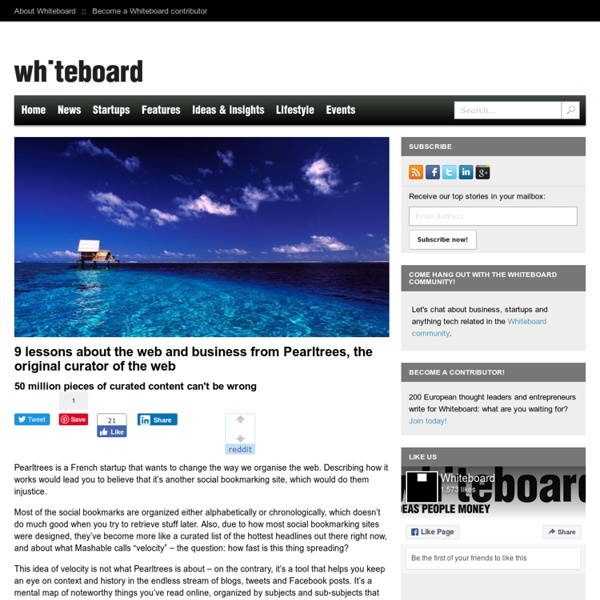Australia finds $1 BEELLION to replace No-SQL DATABASE
That sound? The first drops of a cool billion Australian dollars (US$770m, £520m) that the nation's government has started pouring into a honeypot for the world's technology community. The sweet, sweet pot of dosh is there because Australia has decided it can't go on running System 204, an eighties database, to run its welfare payments agency Centrelink. The agency sends 180,000 letters and emails, and dispenses $290m, every day. System 204's doing that handily, but has reached the point at which meaningful changes are becoming tricky.
Muzio’s beautiful iOS app makes it easier than ever to curate & share memories
What's next in mobile? Find out at MobileBeat, VentureBeat's 7th annual event on the future of mobile, on July 8-9 in San Francisco. Register now and save $400! Tons of apps let you share photos and videos. Heck, just this week, Facebook-owned Instagram added video sharing, and it’s already popular. But what if you want to easily share a set of photos, videos, audio, and text in a single album?
How social media is transforming the fashion industry
Image copyright Brooklyn Beckham/Burberry When Brooklyn Beckham revealed on his Instagram feed that he would be photographing Burberry's latest fragrance ad campaign, the outrage was palpable. Commentators rushed to criticise the fashion house's choice of the 16-year-old son of David and Victoria Beckham for the shoot, instead of an established industry professional. "Insulting to every artist out there"; "completely disrespectful to the artist community"; and "so tired of these celebrities buying their kids into everything" were some of the printable reactions.
Pin-pointing China's attack against GitHub
For the past week, the website "GitHub" has been under attack by China. In this post, I pin-point where the attack is coming from by doing an http-traceroute. GitHub is a key infrastructure website for the Internet, being the largest host of open-source projects, most famously Linux. (I host my code there). It's also a popular blogging platform.
There’s Life Left In Delicious Yet
For a long time, the web-based social bookmarking service Delicious was a poster child for the Web 2.0 movement. It was open, collaborative and full of the tags and user-generated content that made VCs instinctively open up their checkbooks at the time. It’s been 10 years, since the service opened to the public – then still running on the del.icio.us domain – and while it’s changed owners a few times since, it’s still up and running and its original concept hasn’t changed all that much. But the site did give itself a fresh new design for its 10th birthday, so it’s worth taking another look. Yahoo famously acquired Delicious back in 2005, two years after it was founded, and then let it linger for years. That’s what Yahoo did with way too many of these popular Web 2.0 services (Flickr being the other key example) and by 2010, it looked like Delicious’ days were over.
How Technology is Driving the Fashion Industry Forward - Slyce
You probably can relate to the idea of doing research on your phone to determine what shirt would look nice with your new pants while in a shopping mall or boutique. Or maybe you can relate to the practice of taking a picture of yourself in the changing room and having your friend or partner tell you whether they like what you’re wearing or not. A lot has changed in the fashion world in the last several decades, and I’m not talking about the demise of Juicy sweatpants or the disappearance of chain wallets. Technology has turned the entire fashion industry upside down – making all types of fashion more accessible to a large spectrum of consumers, but also more of a challenge for designers and retailers when it comes to competition. Beginning in the mid-1800s, fashion brands were sought through retail catalogues – allowing access from even the most remote locations.
Pin-pointing China's attack against GitHub
For the past week, the website "GitHub" has been under attack by China. In this post, I pin-point where the attack is coming from by doing an http-traceroute. GitHub is a key infrastructure website for the Internet, being the largest host of open-source projects, most famously Linux.
Curation in the Age of Abundance
“A curator is an information chemist. He or she mix atoms together in a way to build an info-molecule. Then adds value to that molecule.” – Scoble One of some buzzwords from SXSWEDU 2012 is “educators as curators”. With lots of Web2.0 curation tools available, what does it mean to be a curator?
A PIECE OF MARKETING PIE FOR CLOUD COMPUTING
November 3, 2015 Barbara McKinney Cloud computing continues to grow and make a difference in the way we work.Forecasted to reach $106B in 2016, it is an opportunity that no technology vendor would want to pass up. While the technology aspect is agog over migration issues and benefits, how has marketing placed their respective companies as cloud players? First of all, like any technology company, even marketers need to cope with the technology jargons. However, this is not to say a technology-laden marketing campaign is what you should launch.
Is hyperconvergence a good thing? Ask a mini computer veteran
Hyper-converged systems integrate compute, storage and networking into a single purchasable entity that is easier to deploy, operate and manage than traditional best-of-breed component systems. They are a step up from converged systems that integrated just storage and compute. That's the simple story – but the definitions are blurry and the boundaries movable. Remember minicomputers? Way back when, even before the PC, minicomputers from DEC and Data General were all-in-one systems with server, operating system software, storage and networking all included with a single purchase order number. Then the rot set in, depending on your point of view, as separate networked storage systems were set up, such as Data General’s 1992 CLARiiON, a RAID high-availability disk array sold with Data General’s Aviion minis.



